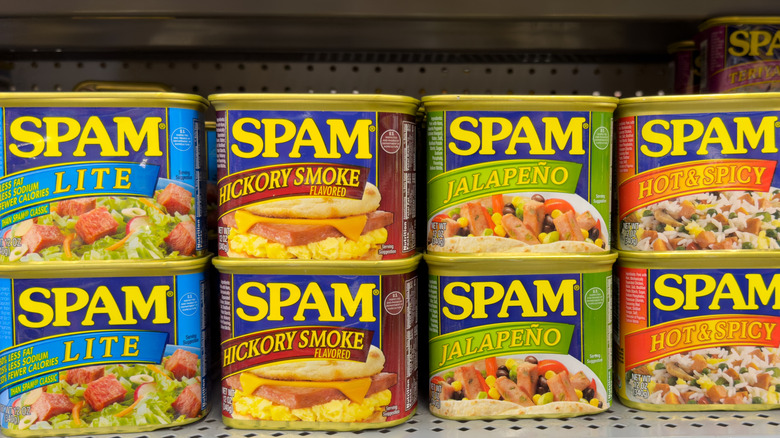How Is Canned Ham Different From SPAM?
It can be very easy to mix up canned ham and SPAM — after all, both are forms of tinned meat first developed by Hormel Foods in the early 20th century. However, there are key differences between how these two pork-based products are manufactured, stored, and eaten. Canned ham is made exclusively from whole or assembled pieces of a pig's hind legs (aka the ham), whereas SPAM is made from a mix of ham hocks and pork shoulder. Though both ready-to-eat products are cooked in their vacuum-sealed tins during production, canned ham is sometimes made with added dry gelatin to seal in the product's moisture, but SPAM forms its own natural gelatin while cooking.
Well known as one of the best canned meats to buy, SPAM is completely shelf-stable and can be stored at room temperature for up to five years. Most canned ham, however, must be stored in the refrigerator and kept for no longer than nine months — though there are some shelf-stable brands that can be stored at room temperature for just as long as SPAM. While both canned ham and SPAM can be eaten directly from the tin, most folks enjoy canned ham by browning it in the oven and topping it with a glaze. SPAM, on the other hand, is beloved around the world for its unique versatility and use in global dishes like Vietnamese-inspired fried SPAM and egg bahn mi, and Korean budae jjigae.
A brief history of SPAM
Of course, there would be no SPAM if canned ham hadn't paved the way. Founded by George A. Hormel in 1891, Hormel Foods was a Minnesota-based fresh meat purveyor before developing the first line of canned ham in 1926. Due to its low price, long shelf life, and ease of preparation, canned ham quickly became an ally for homemakers during the early years of the Great Depression. Once Jay Hormel took over the family business from his father in the late 1920s, he continued to push the innovation of canned products under the Hormel brand. He had the idea to take pork shoulder — a cut typically discarded during production — and mix it with ham to create a new kind of canned meat. Thus, SPAM was born.
Taking its name from the words "spiced ham," SPAM was first introduced to consumers in 1937 and was generally well received in the same vein as canned ham. However, it wasn't until the onset of World War II that SPAM became an internationally recognized and beloved (or bemoaned) brand. Because it was a protein-rich food that could survive years without refrigeration, over 100 million pounds of SPAM were sent to Allied military bases across the globe during the war. Even after most troops returned home, in the years following the war the demand for SPAM as an inexpensive and versatile food source continued to skyrocket in places like the Philippines, South Korea, and Hawaii — which remains one of the top consumers of SPAM to this day.


